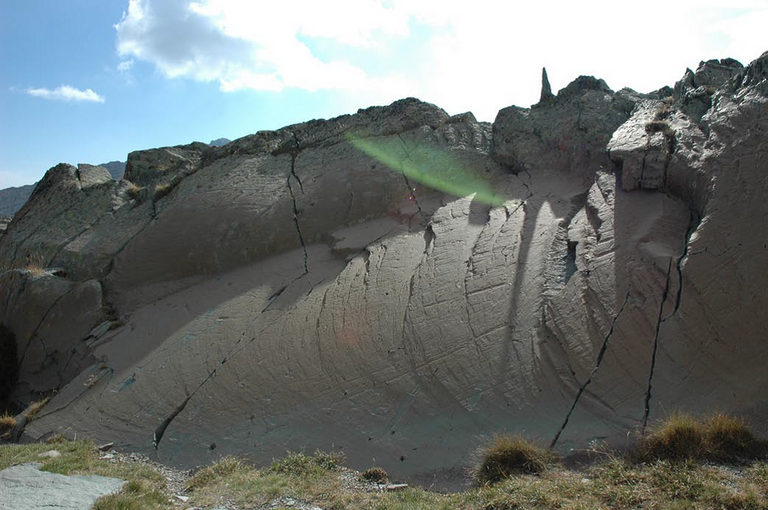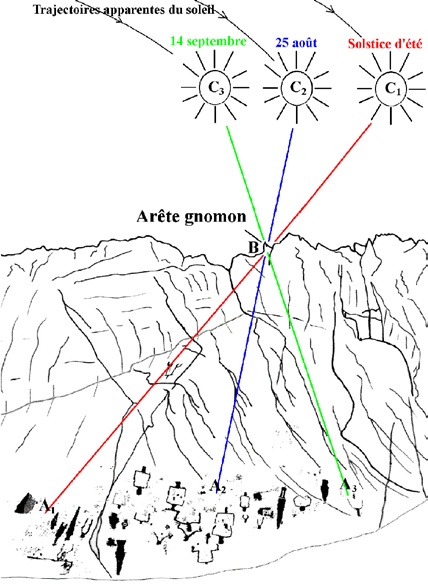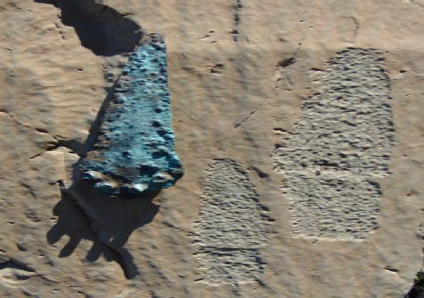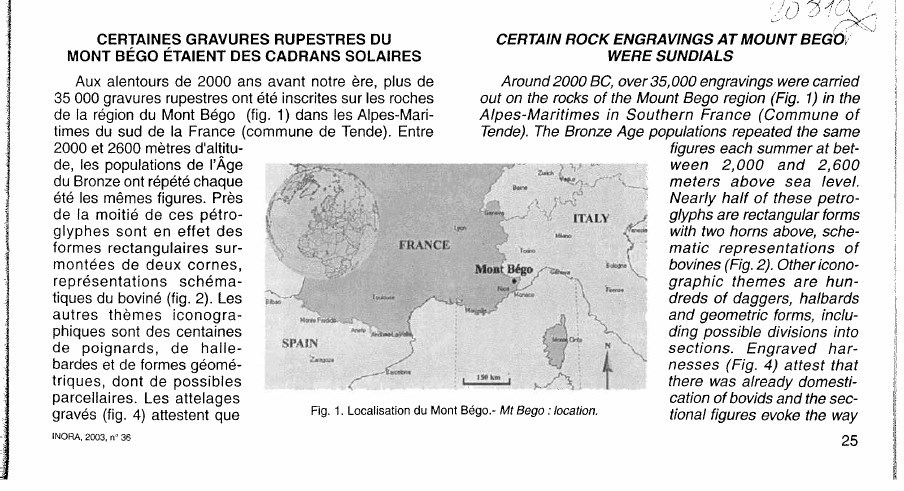The Petroglyph Sundial of Mount Bégo
by Michel Lalos
Michel Lalos is an expert on sundials. He was able to point out a scientific signification for 36 of the 40,000 petroglyphs of Mount Bégo.
In September 2006, in the South sector of the « Valley of Marvels, » the Museum of Prehistorical Anthropology of Monaco pursued its investigation of a carved rock which turns out to be a seasonal sundial conceived some 4,000 years ago. This discovery betrays the preoccupation of humans of this period with celestial phenomena and also shows their ability in elaborating techniques of observation of the apparent movement of sky bodies. The site of Stonehenge in Great-Britain and the Nebra disk, which has been recently discovered in Germany, were already confirmations of a Bronze Age cosmology in which the apparent movement of the sun served to measure precisely the time of the year. The sundial of Mount Bégo figures among the most ancient devices for the measure of solar time.
The observation of traces and carvings associated with computer simulations have permitted these results. It is more precisely in Zone IV of the petroglyphs that this sundial has been engraved by the pastors-labourers of the early Bronze Age.

The rock studied is an inclined plane along an East-West axis at the bottom of which a series of 36 petroglyphs were incised. The top of the rock was also carved in order to shape a gnomonic needle, the shadow of which reaches in the direction of the petroglyphs every evening.

At the base of the slab, these petroglyphs are successively visited by the shadow of the gnomon over the course of the summer.
How was it made and what was its function?

While observing the course of the sunset on the horizon through the whole length of a season, the carvers of Mount Bégo have used its variations in order to create a sundial which would mark the days, not the hours.
So, at first, the carving of a ridge at the top of the rock allowed to generate a shadow at the end of every afternoon. Then, the petroglyphs were carved one after the other, day after day, along a whole season, at the extremity of this shadow which grows longer towards the bottom every evening.
4,000 years ago, the elaboration of this sundial took place probably over a season of 85 days, comprised between the longest day of the year (summer solstice) and what would be today September 14th.
In accord with the date indicated, the carvers changed their theme. On the longest days, for instance, they inscribed a series of daggers with the blade pointed upwards. In the middle of the season, representations of horned animals, sometimes opposed by their horns, sometimes imbricated in each other, were carved. In the following years, this instrument of time measuring allowed humans to read every evening the date of the present day. Still today, at the end of the afternoon, we can observe the length of the shadow growing in the direction of the petroglyphs, despite the crumbling suffered by the needle over the millennia.
How to date this sundial?

Among the carvings of the dial, the figures repesenting daggers of the early Bronze Age afford a relative date for the period of the inscription of the petroglyphs. Around 2000 B.C., daggers had a long triangular blade affixed to a handle by means of rivets. One of those, preserved at the Museum of Prehistorical Anthropology in Monaco, has been found in 1958 on the site of La Madeleine (Hérault) by the team of the Museum, which was then lead by M. Louis Barral. A molding of this weapon was compared to some carvings at the Valley of Marvels at the occasion of the Museum’s last mission.
Research perspectives
It now remains to be discovered for what reason the carvers chose to depict weapons for some dates and figures of horned animals for others. Did they strive to mark important moments relative to agro-pastoral work ? Do some dates correspond to cultic practices? Whatever the reason, the period designated by the sundial corresponds, within a margin of a few days, with the duration of the sojourn in the pastures of shepherds even today. It’s an interesting coincidence, because the climate was the same and the flocks compelled to the same seasonal moves as today. The study of these 36 carvings promises still many reflections to come, in the continuity of the thesis of M. Jérôme Magail, an anthropologist at the Museum of Prehistorical Anthropology of Monaco. The Museum also plans to pursue again the archeological missions to Mount Bégo and will go on site ever summer for intensified research.
Michel Lalos
(translated by Anne-Marie de Grazia)


